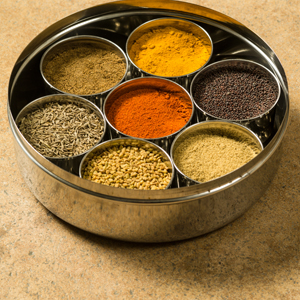Monsoon of Memories: The Quintessential Masala Dibba

There are many things that can be passed on as heirlooms—ornate jewelry, wedding lehengas, antique furniture, and more. But the one thing I’d love to see being passed down from one generation to the other is the humble masala dibba.
At a cursory glance, this unassuming round dibba, traditionally made of stainless steel, may appear to be just one of the many utensils found in Indian kitchens; but when you consider what it has meant for generations of cooking traditions, this hard-working container can be seen for what it is—the crown jewel of Indian kitchens.
The dibba, with its precious contents, is the foundation for Indian cooking. It’s the answer to the question—how does every Indian meal taste so astonishingly good? Just one whiff and you’d be reminded of the flavors, the colors, the health benefits, and, of course, the delish factor of our food.
Typically, the dibba houses seven tiny containers filled with the most common spices used in Indian cooking such as red chilli powder, turmeric powder, cumin seeds, coriander seeds, mustard seeds, asafoetida, and garam masala. The dibba is also a reflection of the diversity and complexity of Indian cuisine as these seven ingredients in the containers vary when we move across the length and breadth of the country.
As a child, I was always in awe of the dibba in my grandma’s kitchen. Often, she’d just use her fingers and sprinkle masala from there—and bring alive a curry with the right color, or a daal with the perfect tempering. Mom too adds just a pinch of the methi seeds or the ajwain seeds from the box to a dish and never fails to cook a great meal! Even though most of the boxes are accompanied by a small spoon, it’s the andazaa (rough estimate) that works best.
The tradition of the dibba continues in my household. There it lies, on my kitchen shelf, and holds whole spices like cinnamon, star anise, and more. While it aids my cooking, it also serves as a treasure trove of memories when I fell in love with the aromas and hues of spices even though I knew very little about cooking. Whole, chopped, roasted, sauteed, fried, or used as simply a garnish—the masalas in the dibba are the secret behind the finger-licking goodness that appears in our thalis.
With time, the masala box too has received a makeover as the traditional stainless steel has given way to fancy plastic, glass, or even brass. Sacrilegious as it seems, they are even peddling square dibbas over the age-old round ones. These contemporary boxes don’t evoke the same feeling of homemade magic.
For, after all, the essence of a masala dibba lies in its functional simplicity that bears no pride about how it is actually the star of every Indian kitchen.
Purva Grover is an author, journalist, poet, playwright, and stage director. A postgraduate in mass communication and literature, she is the founder editor of The Indian Trumpet, a digital magazine for Indian expats in the UAE. She can be reached at grover.purva@gmail.com. To comment on this article, please write to letters@khabar.com.
Enjoyed reading Khabar magazine? Subscribe to Khabar and get a full digital copy of this Indian-American community magazine.
blog comments powered by Disqus










